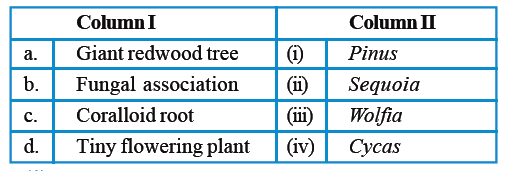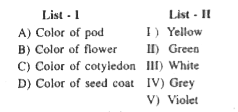Select the correct match:
Agamospermy - Amphimixis
Residual nucellus in seed - Perisperm
Longest seed dormancy - Phoenix dactylifera
Xenogamy - Genetically self-pollination
To solve the question "Select the correct match," we need to analyze each option provided and determine whether the matches are correct or incorrect.
1. Analyze the First Match: Agamospermae and Amphimixes
- Agamospermae refers to a type of asexual reproduction where seeds are produced from unfertilized eggs or ovules.
- Amphimixes refers to sexual reproduction involving the fusion of two gametes to form a zygote.
- Since Agamospermae is asexual and Amphimixes is sexual, this match is incorrect.
2. Analyze the Second Match: Residual Nucellus in Seeds and Perisperm
- Residual Nucellus is the tissue that remains in the seed after fertilization.
- Perisperm is a nutritive tissue that is derived from the nucellus and is deposited externally to the embryo sac.
- Since perisperm is indeed derived from the residual nucellus, this match is correct.
3. Analyze the Third Match: Longest Seed Dormancy and Phoenix dactylifera
- Phoenix dactylifera (date palm) is known for its longevity but does not exhibit the longest seed dormancy.
- The longest seed dormancy is actually seen in lotus seeds.
- Therefore, this match is incorrect.
4. Analyze the Fourth Match: Xenogamy and Genetically Self-Pollination
- Xenogamy refers to the transfer of pollen from the anther of one flower to the stigma of another flower (cross-pollination).
- Self-pollination involves the transfer of pollen within the same flower or plant.
- Since xenogamy is not self-pollination, this match is incorrect.
Conclusion:
The only correct match is the second option: Residual Nucellus in Seeds and Perisperm.
Final Answer:
The correct match is Residual Nucellus in Seeds and Perisperm.
---
- Agamospermae refers to a type of asexual reproduction where seeds are produced from unfertilized eggs or ovules.
- Amphimixes refers to sexual reproduction involving the fusion of two gametes to form a zygote.
- Since Agamospermae is asexual and Amphimixes is sexual, this match is incorrect.
- Residual Nucellus is the tissue that remains in the seed after fertilization.
- Perisperm is a nutritive tissue that is derived from the nucellus and is deposited externally to the embryo sac.
- Since perisperm is indeed derived from the residual nucellus, this match is correct.
- Phoenix dactylifera (date palm) is known for its longevity but does not exhibit the longest seed dormancy.
- The longest seed dormancy is actually seen in lotus seeds.
- Therefore, this match is incorrect.
- Xenogamy refers to the transfer of pollen from the anther of one flower to the stigma of another flower (cross-pollination).
- Self-pollination involves the transfer of pollen within the same flower or plant.
- Since xenogamy is not self-pollination, this match is incorrect.
The only correct match is the second option: Residual Nucellus in Seeds and Perisperm.
The correct match is Residual Nucellus in Seeds and Perisperm.
Topper's Solved these Questions
Similar Questions
Select a correct match:
View SolutionSelect a correct match
View SolutionSelect a correct match
View SolutionSelect out the correct match
View SolutionSelect correct matching :-
View SolutionSelect correct match :
 View Solution
View SolutionSelect correct match:
 View Solution
View SolutionSelect correct match
 View Solution
View SolutionSelect correct matched pair/ pairs:
View SolutionMatch the following and select the correct option

The correct match isView Solution

